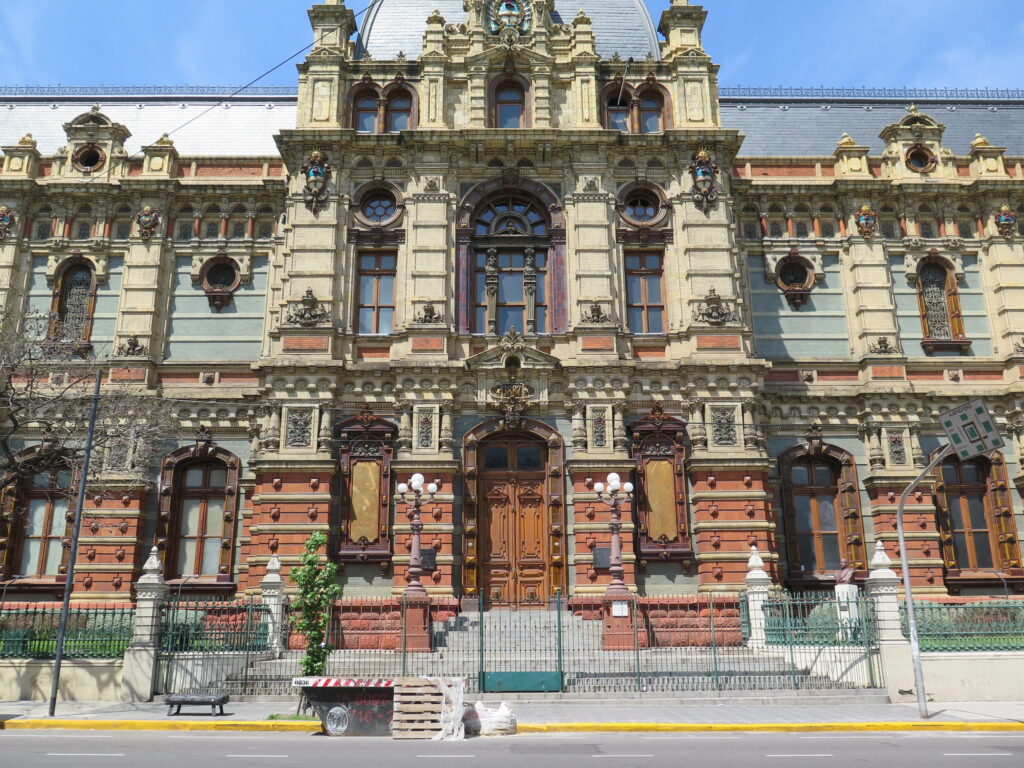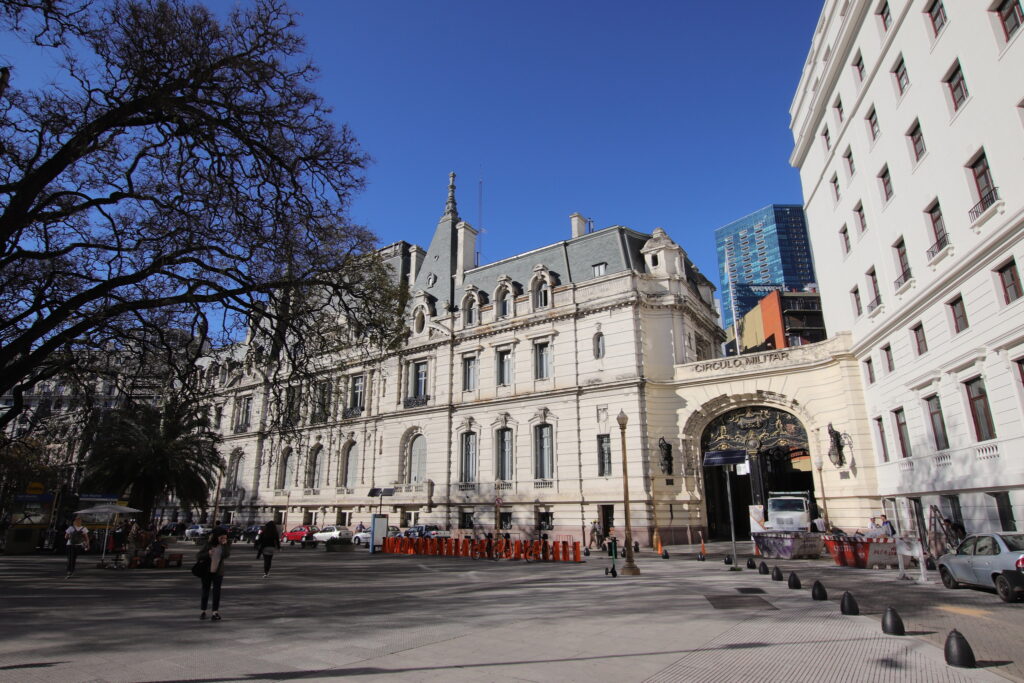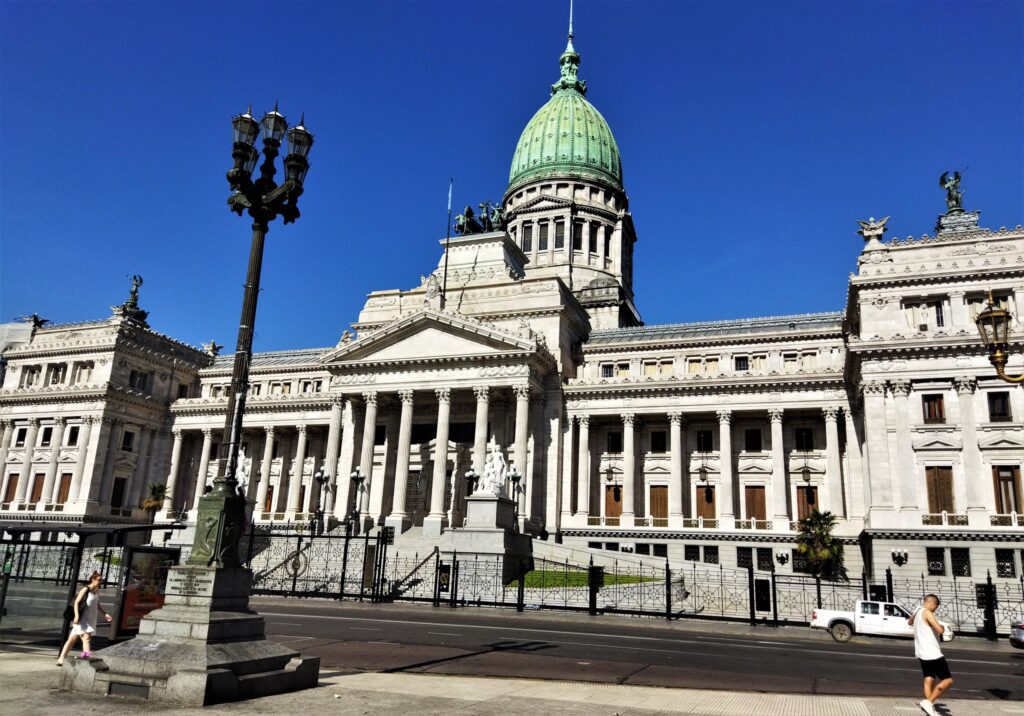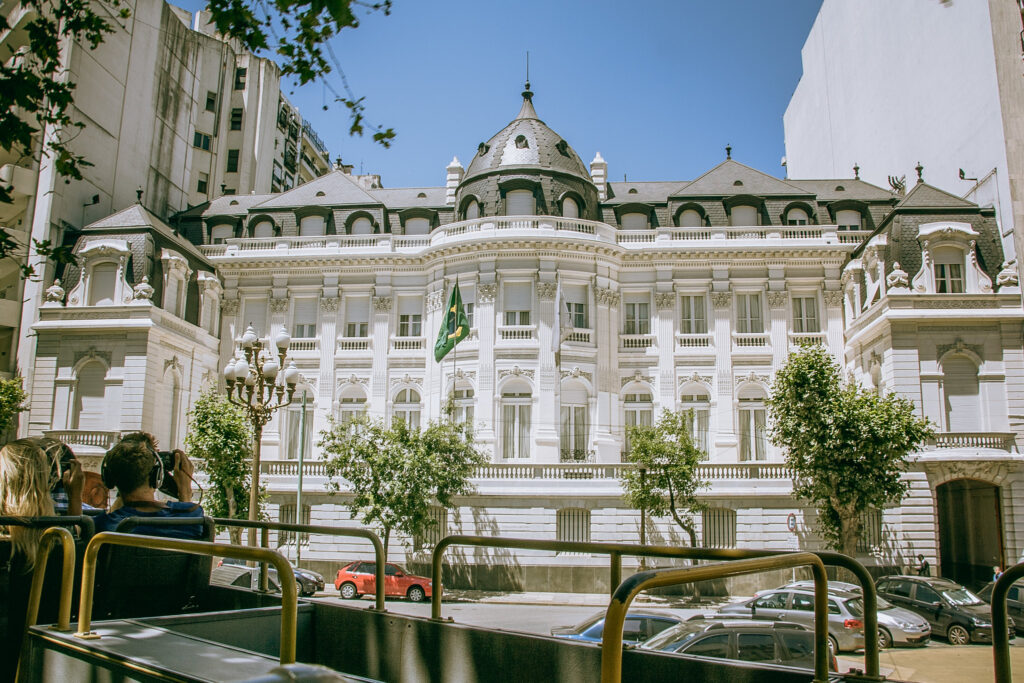Have you ever wondered what secrets lie behind the imposing facades of Buenos Aires’ most beautiful palaces?
ExpatPathways invites you on an architectural journey through the best palaces to visit in Buenos Aires, where each structure tells a story of cultural confluence and the city’s affluent past.
These palatial wonders not only showcase the impact of immigrants on the city’s landscape but also transport you back to Argentina’s early 20th-century golden age.
Whether open for public tours or functioning as private embassies and government buildings, these palaces offer a unique peek into the grandiose lifestyles of the past.
Remember, access might require prior arrangements, so check ahead to ensure you don’t miss out on these exquisite landmarks.
The Best Palaces to Visit in Buenos Aires
1. Palacio Barolo
Location: Av. de Mayo 1370, Congreso.
The Palacio Barolo, inaugurated in 1923, stands as an architectural gem on Avenida de Mayo, once the tallest building in South America.
Designed by Italian architect Mario Palanti for businessman Luigi Barolo, this building was a pioneer in utilizing reinforced concrete and reached a height of 100 meters. The palace’s design is heavily inspired by Dante Alighieri’s “Divine Comedy,” segmented into three parts symbolizing hell, purgatory, and heaven.
Its architecture blends Neo-Gothic and Art Nouveau styles with influences from Indian landmarks like Jaipur’s Palace of Winds and the Rajarani Temple in Bhubaneshwar.
Historical Significance and Challenges
Despite early acclaim, Palacio Barolo faced challenges such as Barolo’s mysterious death, the 1929 global economic crisis, and World War II, which stunted its golden era.
However, concerted restoration efforts peaked during Argentina’s bicentennial celebrations in 2010, culminating in the relighting of its iconic lighthouse, now declared the Bicentennial Lighthouse of Argentina.
The building’s elaborate design and construction techniques have earned it international recognition, making it a must-visit landmark that combines architectural ingenuity with rich literary history.
2. Palacio de la Legislatura Porteña
Location: Perú 160, Plaza de Mayo.
Constructed in 1931 and designed by architects Eduard Le Monnier and Héctor Ayerza, the Palacio de la Legislatura Porteña reflects 18th-century French neoclassicism.
This majestic building is not only the seat of the Buenos Aires city legislature but also a vibrant cultural space that offers public access to its museum, library, and historical archives.
Its towering 97-meter clock tower, equipped with a Westminster clock and five large bells, adds to the grandeur, providing melodious tunes that resonate throughout the surrounding areas.
Cultural Heritage and Public Access
Inside, the palace houses the Golden Hall and San Martín Hall, where artifacts and historical documents are preserved. These spaces, once graced by Eva Perón, now serve as a museum that showcases the city’s legislative history.
The building’s strategic location offers stunning views of Plaza de Mayo and other historical sites, making it a focal point for both political activity and cultural appreciation in Buenos Aires.
Its architecture and historical significance make the Palacio de la Legislatura Porteña a key destination for those interested in the interplay between Buenos Aires’ past and present governance.
3. Palacio de las Aguas Corrientes
Location: Riobamba 750, Balvanera.
Inaugurated in 1894, the Palacio de las Aguas Corrientes is not just a building but a monument to public health and engineering.
As the first major water distribution reservoir in Buenos Aires, this palace showcases an exterior made from over 300,000 glazed and unglazed terracotta pieces imported from Britain, crafted by renowned companies like Royal Doulton & Co. and Burmantofts Co. of Leeds.
Its interior is equally impressive, featuring one of the largest cast iron structures in the continent, with three floors of tanks supported by 180 columns, capable of storing over 72 million liters of water.

Historical Significance and Unique Features
Declared a National Historic Monument in 1989, the palace is a testament to the importance placed on public hygiene and clean water in the early 20th century.
Its intricate terracotta façade and ornate interior ironwork, combined with Paraguayan cedar wood carpentry and British ironwork, reflect a blend of international craftsmanship and local appreciation for detailed and functional architecture.
The building’s unique construction began in 1887 and was equipped with a slate roof imported from Sedán, France, further emphasizing its global connections and local impact.
4. Palacio Álzaga Unzué
Location: Cerrito 1455, Barrio Norte.
The Palacio Álzaga Unzué stands as a testament to the opulent lifestyle of Buenos Aires’ early 20th-century aristocracy. Now operating as part of the prestigious Four Seasons hotel chain since 2001, this palace encapsulates the grandeur and elegance of its era.
Initially part of the vast Hale-Pearson family estate known as Quinta Hale, the area underwent significant transformations at the turn of the century under the guidance of city officials and foreign investment from the Baring Brothers firm.
Transformation and Preservation
The palace’s conversion into urban lots led to the creation of an exclusive neighborhood-park, featuring scenic views and a central plaza.
While many of the original aristocratic residences have been replaced by high-rise apartments due to the urbanization trends and the introduction of the Horizontal Property Law in the 1940s, the Palacio Álzaga Unzué remains a beacon of historical preservation.
Now surrounded by modern buildings, it serves not only as a luxury hotel but also as a cultural relic that offers a glimpse into the city’s affluent past and its evolution into a bustling metropolitan hub.
5. Palacio Duhau – Park Hyatt Buenos Aires
Location: Av. Alvear 1661, Recoleta.
The Palacio Duhau – Park Hyatt Buenos Aires is a testament to Argentina’s golden age in the 1930s, blending the architectural splendor of a French palace from 1934 with contemporary artistic touches by Celedonio Lohidoy.
This luxurious five-star hotel, nestled in the distinguished Recoleta neighborhood, beautifully marries Belle Époque furniture with modern art, creating a unique ambiance that reflects different historical periods.
Each room offers panoramic views of the lush Recoleta landscape, with select rooms featuring fireplaces and whirlpool baths, encapsulating the essence of opulence and comfort.
A Premier Destination for Gastronomy and Relaxation
Inaugurated in 2006 after a $75 million investment, the Palacio Duhau stands as one of Buenos Aires’ most elegant hotels, emphasizing art within its historical mansion.
Its main restaurant serves up Argentine specialties and boasts an extensive wine cellar. Guests can also dine outdoors at the Gioia Restaurante & Terraces, enjoying private terrace views of the palace gardens.
For relaxation, the hotel offers a spa with beauty treatments and massage sessions, enhancing the luxurious experience with every detail tailored to guest comfort.
6. Palacio San Martín
Location: Arenales 761, Retiro.
Originally constructed between 1905 and 1909 for Mercedes Castellanos de Anchorena, the Palacio Anchorena is a brilliant example of Beaux-Arts architecture inspired by Jean Louis Pascal’s award-winning project, “Hotel a Paris pour un riche Banquier.”
Designed by architect Alejandro Christophersen, the palace features ornate facades with sculptural details, including convex mansard roofs, domes, and decorative chimneys.
Purchased by the state in 1936 and renamed the Palacio San Martín, it now serves as the ceremonial headquarters of Argentina’s Ministry of Foreign Affairs, showcasing the adaptability of 18th-century French residential architecture to local Buenos Aires culture.
Cultural and Architectural Treasure
Declared a national historic monument, the Palacio San Martín houses significant artworks by prominent 20th-century Argentine and American artists such as Antonio Berni and Roberto Matta.
It also contains a Pre-Columbian Art Collection from Argentina’s northwest cultures, housed alongside a specialized library in international law and history of international relations.
The palace remains a pivotal piece of Argentina’s architectural and cultural heritage, offering a glimpse into the luxurious social gatherings of the early 20th century, including the notable Centennial Independence Ball of 1916.
7. Palacio Paz
Location: Av. Santa Fe 750, Retiro.
Constructed at the dawn of the 20th century, Palacio Paz stands as a monumental tribute to the Beaux-Arts style, envisioned by Dr. José Camilo Paz and brought to life by French architect Louis-Marie Henri Sortais.
Originally intended as a lavish family residence, its completion posthumously honored its founder, who died before seeing the completion of his vision in 1914. The building’s grandiose design and opulent interiors reflect the luxurious lifestyle of Buenos Aires’ elite during that era.
Today, the palace serves as the headquarters for the Círculo Militar (Military Circle) and the Museo de Armas de la Nación (National Arms Museum), preserving its historical and architectural significance.

A Blend of Art and Elegance
The Palacio Paz is distinguished by its trapezoidal shape and stunning façades that feature a mix of Paris stone-like surfaces now hidden under layers of paint. The palatial structure includes a garden, winter garden, and originally even a carriage house.
Its rich decoration features woodwork from Paraguay and ironwork from English foundries, with numerous provincial shields adorning its walls. The Palacio’s layout is a testament to the societal functions of its time, designed to host grand receptions and embody the lavishness expected of such a prominent family residence.
Today, it stands as a magnificent example of the architectural heritage of Buenos Aires, offering a glimpse into the opulent past of Argentina’s aristocracy.
8. Palacio Fernández Anchorena
Location: Av. Alvear 1661, Recoleta.
Palacio Fernández Anchorena, designed by the renowned French architect Edouard Le Monnier in the early 20th century, exemplifies the grandeur of Art Nouveau merged with classical architectural principles.
Positioned prominently on Avenida Alvear in Buenos Aires, the palace’s symmetrical layout and classical composition are capped with a striking dome that highlights the main entrance, embodying the elegance of Parisian design.
This palatial residence, initially intended for the affluent Fernández Anchorena family, remains one of the few such estates from the era that still stands today, now housing the Apostolic Nunciature of the Holy See.
A Palace with a Story
The history of Palacio Fernández Anchorena is as dramatic as its architecture. Although built for the wealthy Fernández Anchorena family, the original owners never occupied it due to a tragic accident that befell Juan Antonio Fernández in Europe, prompting the family to reside permanently in Paris.
Over the decades, the palace has seen various prominent uses, including a temporary presidential residence and, most notably, as a generous donation to the Holy See, becoming the Apostolic Nunciature.
It has hosted Pope John Paul II during his visits to Argentina and was declared a National Historic Monument in 2002, securing its place as a key piece of Argentina’s cultural and historical fabric.
9. Palacio Balcarce
Location: Av. Pres. Manuel Quintana 161, Recoleta.
Nestled on Quintana Avenue, Palacio Balcarce, designed by British architect Walter Basset B Smith, showcases the refined Edwardian Neobaroque architecture prevalent among Buenos Aires’ elite in the early 20th century.
Constructed between 1913 and 1916 for José González Balcarce, an Oxford-educated patrician, the palace reflects his Anglophile preferences. This grand structure features intricately carved woodwork, majestic bronze chandeliers, and original stained-glass windows, encapsulating the sophisticated aesthetic of its era.
The palace’s interior decor, from the lavish staircases to the detailed ceiling moldings, remains impeccably preserved, exuding an air of historical grandeur.
A Multifaceted Historical Venue
Throughout its history, Palacio Balcarce has served various prestigious roles, including hosting the German embassy during World War II. Today, it stands as the Center for Armed Forces Officers, continuing its legacy within the architectural tapestry of Buenos Aires.
The palace’s four-story structure retains its original faucets, tiles, and a sumptuously ornate ambiance, making it a testament to the city’s rich cultural heritage.
Its conversion into a military center has helped preserve its architectural integrity, allowing it to serve not only as a historical monument but also as a functional space contributing to the community.
10. Palacio del Congreso Nacional
Location: Av. Hipólito Yrigoyen 1849, Plaza Congreso.
The Palacio del Congreso Nacional, designed by Italian architect Víctor Meano and completed in 1946, stands as a monumental beacon of Argentina’s legislative history.
Inaugurated in a partial state in 1906 under President José Figueroa Alcorta, the building’s majestic architecture embodies academicism, eclecticism, and classicism, crowned by a striking 80-meter dome that symbolizes the nation’s democratic aspirations.
The surrounding Plaza del Congreso, established by law in 1905, complements the building, enhancing its civic significance and grandeur, making it a focal point of national pride and cultural identity.

Architectural and Artistic Richness
Declared a National Historical and Artistic Monument in 1993, the Palacio del Congreso not only houses the Argentine legislature but also serves as a custodian of cultural treasures.
Its interiors are adorned with works by prominent Argentine and Latin American artists, including Antonio Berni and Lino Enea Spilimbergo. The building’s design features an array of sculptural works by Lola Mora and a comprehensive collection of historical artifacts that narrate the country’s rich past.
The congress building is both a center for political activity and a repository of the nation’s artistic heritage, reflecting the intertwined nature of Argentine politics and culture.
11. Palacio Ortíz Basualdo
Location: Cerrito 1399, Retiro.
Located at the prestigious intersection of Cerrito and Arroyo streets, Palacio Ortíz Basualdo stands as a testament to the luxurious lifestyles of Buenos Aires’ early 20th-century aristocracy.
Designed in 1912 by French architect Paul Pater, this grand residence originally served the Ortiz Basualdo family, blending the architectural sophistication of Beaux Arts with detailed Parisian-inspired stone façades.
Its interiors, marked by an opulent array of decorative arts, reflect a blend of French classical styles, intricately designed to offer a majestic living space. The palatial structure includes a distinctive trapezoidal layout that integrates seamlessly with its urban surroundings, reminiscent of grand French châteaux such as Vaux-Le-Vicomte.
From Aristocratic Residence to French Embassy
Since 1939, the palace has served as the French Embassy in Buenos Aires, showcasing its enduring relationship with French culture and architecture. The transformation from a private residence to a diplomatic hub illustrates the building’s adaptability and historical significance.
With renovations completed in 2013, the embassy now features modernized façades and interiors while maintaining its historical charm. Visitors and diplomats alike marvel at its well-preserved heritage, making it not only a center for diplomatic affairs but also a cultural landmark in the city.
12. Palacio Errázuriz
Location: Av. del Libertador 1902, Palermo.
Palacio Errázuriz, now the Museo Nacional de Arte Decorativo, is an iconic example of French-inspired architecture in Buenos Aires. Designed by the renowned French architect René Sergent in the early 20th century, this palatial home was commissioned by the affluent Errázuriz family, who envisioned their residence as a future museum.
The architecture features a sophisticated blend of styles, integrating lavish interiors with expansive gardens designed by Achille Duchêne. The palace’s opulent rooms are adorned with European art and furniture, reflecting the family’s exquisite taste and their significant role in Argentina’s social elite.
A Cultural Treasure in the Heart of Buenos Aires
After the economic downturn of 1929, the Argentine government purchased the palace, fulfilling the family’s vision of transforming it into a museum.
Today, the Museo Nacional de Arte Decorativo stands as a testament to the cultural and aesthetic values of its era, offering public access to a rich collection of decorative arts that spans several centuries.
The museum’s dynamic engagement with the public through exhibitions and cultural events continues to highlight the historical importance of the Palacio Errázuriz, making it a key destination for both locals and tourists seeking to experience the grandeur of Buenos Aires’ architectural and artistic heritage.
13. Palacio Bosch
Location: John Fitzgerald Kennedy 3086, Palermo.
The Palacio Bosch, also known as the Palacio Bosch-Alvear, is a significant landmark in Buenos Aires, serving as the residence of the U.S. Ambassador since 1929.
Initially built for Ernesto Bosch, an Argentine ambassador to France, in 1917, the palace showcases the grandeur of French architectural design by René Sergent.
Nestled at Avenida Del Libertador 3502, adjacent to significant city landmarks like the Jardín Zoológico and Parque Tres de Febrero, the palace has hosted numerous U.S. presidents, including F.D. Roosevelt and Barack Obama, during their visits to Argentina.
Its architecture, a product of Sergent’s vision and crafted by local architects Lanús and Hary, stands out for its Beaux-Arts style, marked by Corinthian columns and a symmetry that pays homage to French neoclassical traditions.
Historical Monument and Diplomatic Venue
Declared a National Historic Monument in 2018, the Palacio Bosch spans a history of diplomatic events and U.S. presidential visits, enhancing its prestige and historical value.
The interior, adorned with elaborate décor and art, preserves the essence of its original construction. The transformation from a private residence into a diplomatic venue illustrates its dynamic adaptability and cultural significance, reflecting the deep-rooted diplomatic relationships between Argentina and the United States.
14. Palacio Pereda
Location: Cerrito 1350, Retiro.
Situated on the prestigious Avenue Alvear, the Palacio Pereda stands as a testament to the rich architectural heritage of Buenos Aires. Designed by French architect Louis Martin in the early 20th century, the palace was intended to replicate the Jacquemart André Museum in Paris.
Its construction, completed in 1936, reflects a blend of French classical and Art Nouveau styles, with a façade that mirrors the grandeur of Parisian architecture.
The building’s luxurious interiors are adorned with Carrara marble, majestic frescoes, and a collection of fine arts that captivate all who walk its halls.

From Private Residence to Brazilian Embassy
Originally intended as a private residence, Palacio Pereda has since been transformed into the Brazilian Embassy, continuing its legacy of serving diplomatic purposes.
The transition from a private mansion to an embassy has allowed the palace to maintain its splendid interiors while adapting to its new role in international relations.
Visitors and diplomats alike are treated to a visual feast of historical and artistic significance, making Palacio Pereda a cornerstone of cultural and architectural admiration in Buenos Aires.
15. Palacio Sarmiento (Palacio Pizzurno)
Location: Pje. Pizzurno 935, Recoleta.
The Palacio Sarmiento, historically known as Palacio Pizzurno due to its location on Pizzurno Street, stands as a National Historic Monument of Argentina and houses the Ministry of Education and the National Library of Teachers.
The building, completed in 1893 by Argentine architect Carlos Adolfo Altgelt, reflects an eclectic French style with German influences. Originally intended as a school due to a bequest by Doña Petronila Rodríguez, it temporarily served as a provisional court before becoming the headquarters of the National Education Council from 1903 to 1978.
It was renamed in honor of Domingo Faustino Sarmiento in 1961, celebrating the influential Argentine educator and president.
Architectural and Functional Transformation
Post-1978, the Palacio Pizzurno has been utilized by the Ministry of Education, incorporating various ministry offices previously scattered throughout Buenos Aires.
A significant renovation in 1980, led by architect Félix Ruiz Martínez, modernized its facilities to suit its educational and administrative functions, enhancing spaces such as meeting rooms and conference halls.
The palace’s design, marked by slate mansard roofs and Versailles-inspired facades, adds a regal dimension to its educational purpose, making it a cornerstone of Argentina’s architectural and cultural heritage.
In 2006, the edifice and its surroundings were officially declared a National Historic Monument, securing its status as a key educational and historical site in Buenos Aires.
(Featured Image Source: Turismo Buenos Aires/flickr.com)


